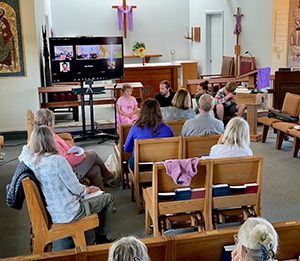John 20:19-31 - Resurrection Appearances
John 20: 19) When it was evening on that day, the first day of the week, and the doors of the house where the disciples had met were locked for fear of the Jews, Jesus came and stood among them and said, “Peace be with you.” 20) After he said this, he showed them his hands and his side. Then the disciples rejoiced when they saw the Lord. 21) Jesus said to them again, “Peace be with you. As the father has sent me, so I send you.” 22) When he had said this, he breathed on them and said to them, “receive the Holy Spirit. 23) If you forgive the sins of any, they are forgiven them; if you retain the sins of any, they are retained.” 24) But Thomas (who was called the Twin), one of the twelve, was not with them when Jesus came. 25) So the other disciples told him, “We have seen the Lord.” But he said to them, “Unless I see the mark of the nails in his hands, and put my finger in the mark of the nails and my hand in his side, I will not believe.” 26) A week later his disciples were again in the house, and Thomas was with them. Although the doors were shut, Jesus came and stood among them and said, “Peace be with you.” 27) Then he said to Thomas, “Put your finger here and see my hands. Reach out your hand and put it in my side. Do not doubt but believe.” 28) Thomas answered him, “My Lord and my God!” 29) Jesus said to him, “Have you believed because you have seen me? Blessed are those who have not seen and yet have come to believe.” 30) Now Jesus did many other signs in the presence of his disciples, which are not written in this book. 31) But these are written so that you may come to believe that Jesus is the Messiah, the Son of God, and that through believing you may have life in his name.
Issues in John:
The gift of the Spirit and peace: In John’s Gospel the gift of the Holy Spirit occurs on Easter evening and not some time later on the day we call Pentecost, as Luke records. For John, the Easter event is one all encompassing event which is like a second creation or a new birth for the church and for the world. The imagery of Jesus’ breathing the Spirit onto (into) the disciples is reminiscent of God’s breathing the breath of life into the first human beings in creation, an event, of course in which Jesus, as part of the Godhead, participated. The Hebrew and Greek words for “Spirit” are also translated as “breath” or “wind”. In some early Christian communities, breathing became a part of ordination rituals. The story is told that the Coptic Patriarch of the church in Alexandria Egypt, filled a skin with his breath. Then it was tied and transported up river to Ethiopia where it was let loose on the one designated to become the head of the church there. (Raymond Brown, The Gospel According to John)
The Commission of the Church: With the gift of the Spirit comes the commission of the church. In John the church is to continue the work of Jesus for all generations. That work is primarily seen as the forgiveness of sins.
Sin and Forgiveness: To understand verse 23, it is important to remember that in this passage John is addressing the entire faith community. The disciples did not refer just to the, then, Eleven, but to all who gathered to follow Jesus. Forgiveness of sin was not reserved for a special few to dispense. Forgiveness was the activity of the entire community of faith, entirely dependent and driven by the gift of the Spirit. Sin, is understood in John, not as a moral or behavioral failing, but as theological blindness. (See John 3:19-21, 8:21-24, 9:39-41, 15:22-24) To have sin is to be blind to the revelation of God in Jesus Christ. The commission of the church, to loose from sin, is the commission to continue to work to make God known and therefore to bring the world to sight and to repentance.
Word Study
Vs. 19 – evening – the time just before sunset. In John the imagery of darkness has played a key role. Remember Nicodemus coming to Jesus in the darkness. It was a time for blind-hearted people to work in secret. It was a time of danger.
Peace be with you – a slightly changed common greeting. In Hebrew this form of common greeting was usually associated with a coming revelation (like “Hey, have I got something to tell you!). It put the one greeted on notice that things would change as a result of what was about to happen. It was not a wish, like saying “I hope or pray that peace will come to you.” It was a statement of fact. In Jesus’ presence, peace and revelation are currently present.
Vs. 23 – you –(plural) This makes clear that the responsibility for forgiveness rests with the whole community, not just a few.
Vs. 25 – told him – lit. kept on telling or kept on trying to tell.
Vs. 27 – doubt – the word for doubt does not appear in the Greek text. A literal translation would be “Do not be unbelieving, but believing.” Thomas’ doubt is never mentioned and is not the point. The point is Jesus’ action.
Vs. 28 – My Lord and My God – the earliest creed of the Christian Church. In this statement Thomas makes clear that God is fully revealed to us in Jesus Christ.
Vs. 31 – John reveals his purpose for writing his gospel in this verse. It is written so that people may come to believe that Jesus is the Messiah, the Son of God, and that through believing, have life in his name.
Questions for Personal Reflection
1. What are the aspects of faith that are most difficult for you? If you are a skeptic in matters of faith, how has that made you feel? About yourself? About your relationship to the church? About God? How might you receive Jesus’ welcome of you more personally?
2. Forgiveness is abundant in Scripture. Are there areas of your life that you have difficulty giving over, loosing to, God’s forgiving love? How has the church helped or hindered you in giving or receiving forgiveness?
3. What is the evidence upon which you base your faith? What do you consider to be your personal commission as a part of the church of Jesus Christ?
4. What are the ways that you feel called to “enter in” to the experience of Christ?



